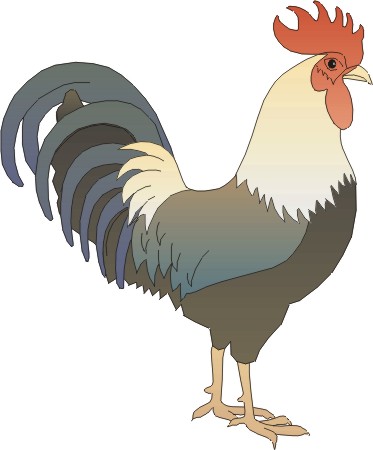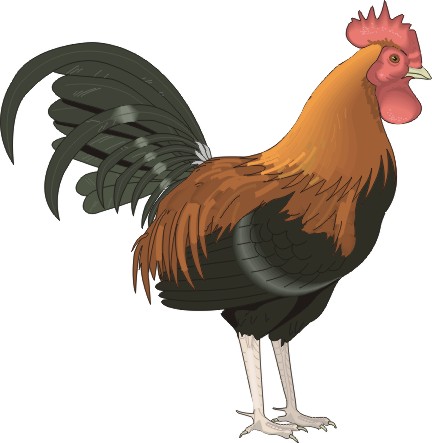The graphics illustrating this activity were not part of the original document.
The source page number appears in brackets before the text of that page
34. Ha-ka mo-a - COCK-FIGHTING

[Page 217] Cocks (mo-a ka-ne, mo-a ka-ka-la) [Page 218]] are fought on holidays in the public squares, bets of pigs, chickens, cocoanuts, etc., being wagered on the contests. The battles are to the death. The combs are not trimmed, but the spurs are cut off and the cocks fight with their beaks. A good fighting cock costs five dollars. The name is from ha-ka, "to fight," and mo-a, "a fowl." A drawn game is called pai-wa-le, and the assembly at a cockfight, a-ha-mo-a.
Ellis1 states that cock-fighting (faatito raamoa literally, causing fighting among fowls) was the most ancient game among the Tahitians. He remarks:

"The traditions of the people state that fowls have existed in the islands as long as the people, that they came with the first colonists, or that they were made by Taaroa at the same time that men were made. The traditions and songs of the islanders connected with their amusements are as ancient as any in existence among them. They do not appear to have laid bets on their favorite birds, but to have trained and fought them for amusement. The fowls designed for fighting were fed with great care; a finely carved fatapua, or stand, was made as a perch for the birds. This was planted in the house, and the bird fastened to it by a piece of cinet, braided flat, that it might not injure the leg. No other substance would have been secure against the attacks of his beak. Their food was chiefly poe, or bruised bread-fruit, rolled up in the hand like paste, and given in small pieces. The fowl was taught to open his mouth to receive his food and his water, which was poured from his master's hand. It was also customary to sprinkle water over these birds to refresh them. The natives were universally addicted to this sport. The inhabitants of one district often matched their birds against those of another, or those of one division of a district against those of another. They do not appear to have entertained any predilection for particular color in the fowls, but seem to have esteemed all alike. They never trimmed any of the feathers, but were proud to see them with heavy wings, full-feathered necks, and long tails. They also accustomed them to fight without artificial spurs or other means of injury. In order that the birds might be as fresh as possible, they fought them early in the morning, soon after day-break, while the air was cool, and before they became languid from heat. More than two were seldom engaged at once, and as soon as [Page 219] one bird avoided the other, he was considered as vi, or beaten. Victory was declared in favor of his opponent, and they were immediately parted. This amusement was sometimes continued for several days successively, and, as well as the other recreations, was patronized by their idols. Ruaifaatoa, the god of cock-fighters, appears among the earliest of their inferior divinities.
 J. Stanley Gardiner2 says of Rotuma: "The chiefs used to breed a
small cock, somewhat similar to the Malayan fowl; great care was taken in the
feeding, and the spur was especially sharpened and oiled. Usually pigs were put
up on both sides, and went to the conquerors."
J. Stanley Gardiner2 says of Rotuma: "The chiefs used to breed a
small cock, somewhat similar to the Malayan fowl; great care was taken in the
feeding, and the spur was especially sharpened and oiled. Usually pigs were put
up on both sides, and went to the conquerors."
Notes:
1. Vol. 1. p. 221.
2. Journal Anthropological Institute, vol. XXVII, p. 486.
Last update February 2, 2010